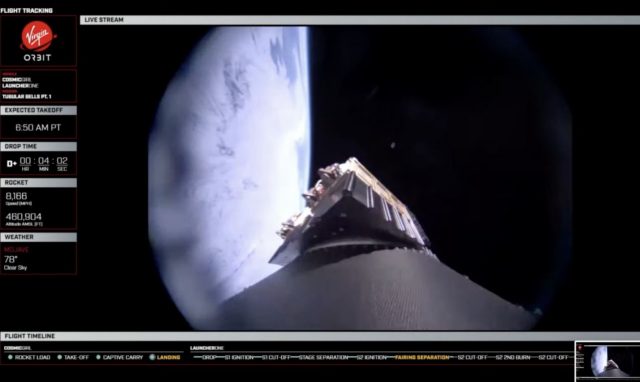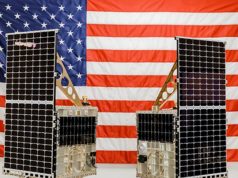The United States deployed six satellites during two separate launches from Florida and California on June 30.
In Florida, the Space Development Agency launched its first two satellite missions, Mandrake II and Laser Interconnect Networking Communications System (LINCS) and the Prototype On-orbit Experimental Testbed (POET) payload, from the Cape Canaveral Space Force Station.
The launch, supported by SpaceX’s Transporter 2, an all-rideshare Falcon 9 mission, carried aboard SDA’s first two sets of experimental satellites, designed and built with government and industry partners, to gather data on optical communication terminal (OCT) performance in low-Earth orbit (LEO), along with the POET payload to demonstrate on-orbit data fusion, proving out core capabilities required for SDA’s future development efforts.
Optical links between space, air, and ground assets offer significantly higher data rates and lower latency when compared to conventional radio frequency links, and demonstrate a pathway of getting real-time data to warfighter.
Once on-orbit, POET will demonstrate integration of a third-party multiple intelligence (multi-INT) data fusion software application in a LEO satellite modular and upgradeable mission software suite running in an edge-processor that is representative of what is planned for the National Defense Space Architecture’s (NDSA) Tranche 0 constellation.
“SDA is relying on OCTs to get massive amounts of data off of sensors and into warfighters’ hands faster than has ever been possible,” said Derek Tournear, SDA director. “Today’s missions will provide real-world data that we can use to verify our engineering assumptions and space-qualify a significant emerging technology.” He continued, “The lessons learned from on-orbit experiments and tests will directly impact future SDA missions, in line with our spiral development concept.”
On Mandrake II, SDA is working with government partners DARPA and Air Force Research Laboratory to evaluate the pointing, acquisition, and tracking algorithms that allow for OCTs to establish and maintain high-speed communication links. The mission will also characterize data transfer rates and optical link performance between space vehicles in LEO and from space to ground. Immediately after separation from the launch vehicle, the pair of Mandrake II space vehicles will gradually drift apart on orbit, allowing for tests at increasing ranges up to 2,400 kilometers.
For the LINCS mission, SDA teamed with General Atomics (GA) to collect the same general data as the Mandrake II mission with OCTs designed and manufactured by GA that offer increased performance. SDA and GA will also take this technology a step further by demonstrating space-to-air optical links between a LINCS space vehicle and a specially developed OCT pod for the MQ-9 Reaper unmanned aerial vehicle. In addition to increasing bandwidth, optical links are also more difficult to detect and disrupt than traditional communication links, enhancing communication in less- and non-permissive environments.
In California, the US Space Force (USSF) Space and Missile Systems Center (SMC) and VOX Space, a Virgin Orbit subsidiary, successfully launched four research and development satellites on Virgin Orbit’s LauncherOne from the Mojave Air and Space Port.
The mission, designated STP-27VPA, demonstrated commercially available solutions for placing USSF satellite capabilities on-orbit from a non-traditional location.
STP-27VPA is the first DoD mission to utilize VOX Space’s “LauncherOne” air-launch system, deploying from a modified 747 aircraft.
The air-launch is a technique in which a rocket is launched from under the wing of a jet aircraft, rather than from a traditional launch pad on the ground.
“Congratulations to the VOX Space and SMC team on today’s successful demonstration, an important milestone in expanding space access,” said Col. Tim Sejba, program executive officer for Space Development Corps. “The success of our Rapid Agile Launch Initiative is a critical component in SMC’s pivot to a more resilient space enterprise.”
The DoD experimental satellites onboard the VOX Space launch include R&D missions sponsored by the United States Army Space and Missile Defense Command, the Naval Information Warfare Center Pacific, and the Missile Defense Agency. These experiments and demonstrations will advance multiple technologies related to CubeSat-based laser communications, localized space-based communication networks, radio frequency measurement technology, and autonomous maneuvering systems. All of these satellites will demonstrate advanced space technologies and accelerate the fielding of future space systems for US government agencies and operational space capabilities for the USSF and DoD.
“We are very excited about today’s successful launch,” said Col. Carlos Quinones, director of the DoD Space Test Program. “Today the DoD Space Test Program and VOX Space met the congressional goal to procure a new DoD launch capability and agilely deliver R&D payloads to orbit.”

























